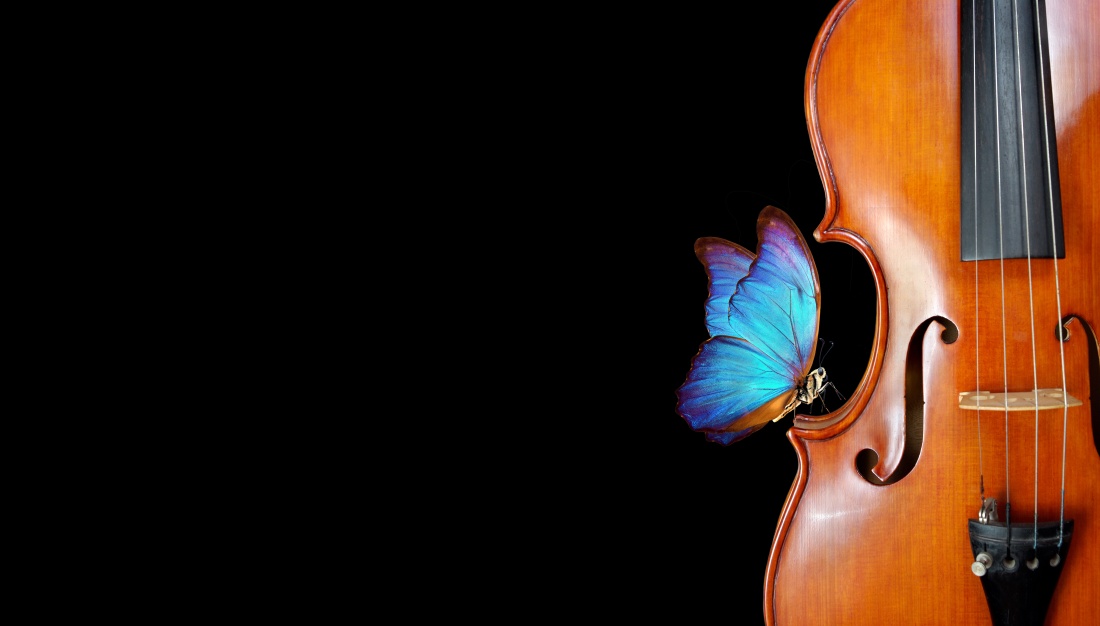by Sabrina Borzaga
A teacher at ISTD’s Imperial Classical Ballet Faculty and a member of Unesco’s CID, Sabrina is a director and choreographer specialising in performances with live orchestra and ensemble accompaniment. She developed the “Entolé Danza a 432 Hertz” method, with the aim of giving dance students further opportunities to connect with music through string instruments such as violin and cello.
Everything is sound, nothing but sound. The stars are sound, their planets and their contents. The elements belong to sound as well as what they form, from the simplest organisms to the most complex ones: the vegetable and animal kingdom. The human being is sound, even though they have forgotten.
Alfred Tomatis (translation Tamara Tempera)
The class is about to start; the musicians position the music stands, open the cases, take their instrument; then they rub the rosin on the bow, sit down and start tuning. In that precise moment, the magic begins; the eyes of the students start sparkling… they all watch attentively the ritual of the tuning… For a moment, it feels like being in a theatre; no one speaks; everybody is watching and listening. At last the tuning ends; they have set the strings in perfect harmony at the same frequency of 432 Hertz, as requested.
Many think I no longer notice it, but the ritual of the tuning always fascinates me and I have the same expression on my face as my students even if it’s 14 years that I listen to the quartet tune.
Yes, tuning… the first thing to be explained to students is that they are musicians, too and need to move in perfect harmony. Such a special moment teaches students that just like musicians they too have to “tune” all the time; that they are not solo dancers but that – in order for the choreography to work out perfectly and make sense – they have to move as one organism, exactly like a symphony orchestra.
Something magical happens, but scientific as well; the frequency of the tuning gives resonance to the heart chakra, that’s why it is so touching. Nothing happens by chance.
Because music is not just a cerebral stimulus. Music has the ability to penetrate our depths.
Peppe Vessicchio, La musica fa crescere i pomodori (Music can make tomatoes grow), p. 183
It can speak to our cells and with a part of ourselves we do not know.
(translation Tamara Tempera)

Unfortunately, we can’t bring a full orchestra in the dance studio, but we can definitely have two or three instruments! To make students used to the connection with more instruments, the Entolé method includes classes which are accompanied by violin and cello or jazz trio with saxophone or clarinet, bass and drum set.
The most suitable accompaniment for a ballet class is that with violin and cello, but to accustom the ear to different sounds, a musical style such as jazz is particularly suited to the hardest parts of the lesson, i.e. jumps and points.
This ensemble is especially useful for those who display any musical difficulties. The use and rhythms of the drum set allow the student to quickly understand the musical style and tempi. The decisive and clean timbre of the sticks on the drums, cymbals and snare drum accompanies the dancer in the elevation and encourages them to respect its speed.
The jazz ensemble also includes a string instrument, the electric bass. This instrument, developed in the 1950’s, subs for the double bass and represents a guide and constant reference for the succession of pulses within bars. The melody is given to clarinet and sax instead. Both are important to develop the melody, which needs to be translated with the right interpretation and expression. The clarinet belongs to the woodwind family, and its three registers – low, medium, high – translate into three types of sound which we can refer to for specific exercises. The warm and mellow sound of the low register is consistent with the musical requirements of Adages, battements fondu, port de bras. The bright sound of the medium register is well suited to battements tendus, battements glissé, battements jeté, grand battements and pirouettes. The powerful and sharp sound of the high register is particularly suitable for allegros and grand allegros.
The soft and velvety, but at the same time powerful, sound of the saxophone is appropriate for point exercises, as well as for jumps. Its timbre facilitates raising on points and take off during jumps. In classes for children aged 4-10, the use of such instruments, which can excellently manage improvisation, allows for group enchainements and enhances the students’ interpretation and expression. The interaction between students and musicians can create not just workshops but also real scripts for a ballet.
The sum of these sounds is really fascinating and suitable to students of any age and ability.

https://kaspercornish.bandcamp.com/album/the-string-quartet-dances (link to my String Quartet for ballet class in 24 movements) it was scheduled to be recorded band released this year but has been postponed. The link is an audio sample of the first movement.
LikeLike
What an extravagant joy! I often think if another instrumentalist came into class the dancers would be in awe.
LikeLike